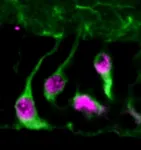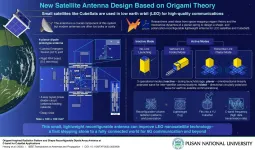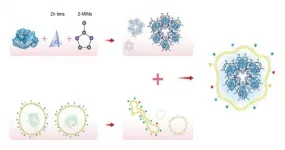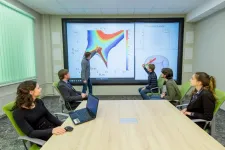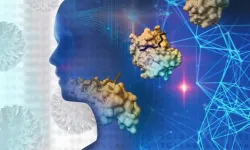(Press-News.org) Just as beneficial microbes in the human gut can be affected by antibiotics, diet interventions and other disturbances, the microbiomes of other animals can also be upset. In a rare study published this week, Andrea Jani, a researcher with the University of Hawai'i at Mānoa School of Ocean and Earth Science and Technology (SOEST), determined the skin microbiome of an endangered frog was altered when the frogs were infected by a specific fungus, and it didn't recover to its initial state even when the frog was cured of the infection.
All animals host symbiotic microbes--many of which are beneficial--within and on their bodies. For optimal health, this microbial community needs to remain robust and fairly stable, either by resisting change or by recovering effectively after a disruption. Some infectious diseases disrupt the microbiome, but very little is known about what happens after the host is cleared of infection.
FUNGUS PROMPTS SPECIES EXTINCTIONS
Batrachochytrium dendrobatidis (Bd) is a fungus that infects the skin of amphibians and since its discovery just over two decades ago, Bd has emerged as a global threat to amphibians. This pathogen has affected hundreds of species and driven massive population declines, including 90 presumed species extinctions--representing the greatest known disease-induced biodiversity loss.
Jani led a team of researchers from the San Francisco Zoological Society, Sequoia and Kings Canyon National Parks, USDA Forest Service and the University of California to study the skin microbiome of the mountain yellow-legged frog (Rana muscosa), an endangered species in the Sierra Nevada in California.
"Many populations of these frogs have been wiped out by Bd infection, and the fate of remaining populations will depend largely on their ability to survive despite the presence of the pathogen," said Jani.
ATTEMPTS TO PROTECT FROGS
Researchers and conservation managers have tested immunization as a method to protect the frogs. Frogs were taken into captivity, deliberately infected with the pathogen, and then cleared of their infections using antifungal drugs, in an attempt to train their immune systems to recognize and fight the pathogen. The frogs are then released back to the wild.
During one of these trials, Jani sampled the skin microbiomes of the frogs before they were exposed to the pathogen, after they were infected, and again after they had been cleared of infection. She then used genetic sequencing technologies to identify the bacteria present.
"We found that Bd infection disturbed the frog microbiome by altering the relative abundances of core bacterial species, just as we had observed in previous research," said Jani. "But surprisingly, when the frogs were cleared their infections, their microbiomes did not recover. In other words, removing the cause of the microbiome disturbance was not enough to bring about recovery from the disturbance."
MICROBIOME AS 'BODY GUARD'
Establishing whether the microbiome can be resilient after disease is important to a basic understanding of microbiome dynamics, as well as the effects of infectious diseases.
Bacteria inhabiting the skin of amphibians have the potential to provide some resistance to disease conditions. Some researchers are exploring whether probiotics can protect wild amphibians, especially endangered species.
"We would hope that the microbiome can act as a 'body guard,' but that possibility may be compromised if a Bd infection can change the microbiome itself," said Jani.
"Among the key unanswered questions are whether and how the disturbance to the microbiome affects the functions it provides for the host," she added. "In our recent study, we found that greater shifts in the microbiome were linked to greater weight loss by the frogs, which suggests--but doesn't prove--that microbiome change may have been detrimental. As with many microbiome studies, it can be very difficult to tease apart cause and effect."
CONSERVATION OF HAWAI'I WILDLIFE
Hawai'i is home to a wealth of endemic biodiversity, but also has one of the highest extinction rates on the planet. Although Hawai'i has no native amphibians, infectious diseases have decimated and continue to threaten Hawaiian species, such as the iconic O'hia and several forest bird species.
"Conservation of Hawaiian species will require understanding of how infectious diseases affect Hawaiian wildlife, including effects on associated microbiomes," said Jani. "Hawaiian species' microbiome sensitivity and resilience to infectious disease is not well understood, but a broad understanding of these processes in other species may provide initial insights and guide future research with Hawaiian species."
With a wide variety of microbiome research being conducted in Hawai'i, the UH Mānoa Center for Microbiome Analysis through Island Knowledge and Investigation (CMAIKI) connects microbiome scientists, including Jani, across the islands, furthering collaboration and facilitating new discoveries related to environmental and human health.
INFORMATION:
WASHINGTON--Chinese people are more likely to face high blood pressure and other health risks as a result of higher body mass index (BMI) and waist circumference than people from other racial and ethnic groups, according to a new study published in the Endocrine Society's END ...
SINGAPORE, 10 February 2021 - Researchers studying an enzyme in fruit fly larvae have found that it plays an important role in waking up brain stem cells from their dormant 'quiescent' state, enabling them to proliferate and generate new neurons. Published in the journal EMBO Reports, the study by Duke-NUS Medical School, Singapore, could help clarify how some neurodevelopmental disorders such as autism and microcephaly occur.
Quiescent neural stem cells in the fruit fly larval brainPr-set7 is an enzyme involved in maintaining genome stability, DNA repair and cell cycle regulation, as well as ...
Modern telecommunication systems rely on satellites to relay signals across the globe quickly and reliably, enabling users to send messages across the world in an instant, watch live television, or - more recently - hold conference calls with global partners right from the kitchen table!
Communications satellites use high-frequency radio waves to transmit data, with antennas acting as a two-way interface, converting electric current provided by the transmitter into radio waves, and vice versa when paired with a receiver. Antennas are therefore vital pieces of equipment, without which satellites and ground receivers would be practically useless. However, despite advances in modern satellite design and performance, antenna technology remains a limiting factor for ...
With the advent of 5G communication technology and its integration with AI, we are looking at the dawn of a new era in which people, machines, objects, and devices are connected like never before. This smart era will be characterized by smart facilities and services such as self-driving cars, smart UAVs, and intelligent healthcare. This will be the aftermath of a technological revolution.
But the flip side of such technological revolution is that AI itself can be used to attack or threaten the security of 5G-enabled systems which, in turn, can greatly compromise their reliability. It is, therefore, imperative to investigate such potential security threats and explore countermeasures before a smart world is realized.
In a recent study published ...
Researchers at the University of Virginia School of Medicine have shed light on what causes herpes simplex virus to flare up, explaining how stress, illness and even sunburn can trigger unwanted outbreaks.
The discovery could lead to new ways to prevent cold sores and herpes-related eye disease from reoccurring, the researchers report.
"Herpes simplex recurrence has long been associated with stress, fever and sunburn," said researcher Anna R. Cliffe, PhD, of UVA's Department of Microbiology, Immunology and Cancer Biology. "This study sheds light on how all these triggers can lead to herpes simplex-associated disease."
About Herpes Simplex ...
Joe Biden is the new president of the United States, although half of the country's Republicans believe he stole the election. A lot of people believe conspiracy theories on the other side of the Atlantic. But they aren't only found there.
Conspiracy theories are not exclusive to people who storm the U.S. Capitol.
"Everyone believes at least one conspiracy theory," says Asbjørn Dyrendal, a professor in NTNU's Department of Philosophy and Religious Studies who specializes in conspiracy theories.
The more conspiracy theories you bring up, the more people answer yes to one of them.
That fact leads ...
Loading a cancer immunotherapy drug onto a metal organic framework improves both its delivery and its sustained release for treating leukemia. Furthermore, coating the drug-loaded framework with a cancer cell membrane improves targeted delivery to solid tumors. These findings could lead to safer and more reliable cancer immunotherapies.
"We believe our findings are quite significant because they show that the undesirable side effects of immunotherapy can be modulated by choosing the right delivery vehicle," says KAUST chemist Niveen Khashab. "They also show that targeted delivery can be realistically established through proper surface functionalization." ...
The energy of the future lies in the area of the controlled thermonuclear fusion. The scientific group from Peter the Great St.Petersburg Polytechnic University (SPbPU), headed by Professor Vladimir Rozhansky, is directly involved in the establishment of the world's largest experimental thermonuclear reactor ITER. Researchers discovered new effects, which affect the energy flow in the reactor. The theoretical predictions were confirmed by the experiments on two tokamaks. The research results were published in the scientific journal "Plasma Physics and Controlled Fusion".
The scientific group of Polytechnic University is engaged in modeling of the edge plasma. The researchers aim to identify how and ...
In the early days of the COVID-19 pandemic, it was established that SARS-CoV-2 infects cells by binding to the human protein ACE2, which plays a role in regulating blood pressure. But ACE2 is almost absent in human lung cells, so how can the lungs be one of the most affected organs in COVID-19? This gave researchers a hint that ACE2 might be more than just a blood pressure regulator, and might not be the only player in the SARS-CoV-2 infection mechanism.
EMBL's Gibson team, in collaboration with Lucía Chemes at Universidad Nacional de San Martín in Buenos Aires and ...
Research from the Business School (formerly Cass) suggests that observing others' decision-making can teach people to make better decisions themselves.
The research, co-authored by Professor Irene Scopelliti, Professor of Marketing and Behavioural Science, tested the effectiveness of a new debiasing training strategy and reports first evidence that watching others make decisions can improve our own decision making.
The authors carried out three experiments, which involved participants making a set of judgements before and after a training intervention designed to improve their decision-making.
Experiment ...

